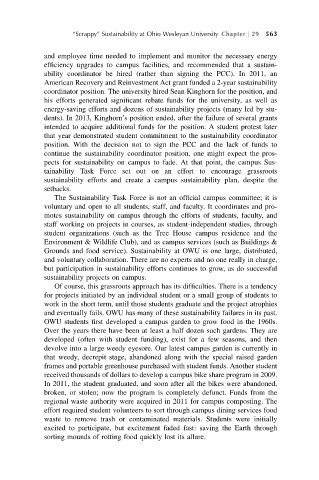Page 596 - Sustainable Cities and Communities Design Handbook
P. 596
“Scrappy” Sustainability at Ohio Wesleyan University Chapter j 29 563
and employee time needed to implement and monitor the necessary energy
efficiency upgrades to campus facilities, and recommended that a sustain-
ability coordinator be hired (rather than signing the PCC). In 2011, an
American Recovery and Reinvestment Act grant funded a 2-year sustainability
coordinator position. The university hired Sean Kinghorn for the position, and
his efforts generated significant rebate funds for the university, as well as
energy-saving efforts and dozens of sustainability projects (many led by stu-
dents). In 2013, Kinghorn’s position ended, after the failure of several grants
intended to acquire additional funds for the position. A student protest later
that year demonstrated student commitment to the sustainability coordinator
position. With the decision not to sign the PCC and the lack of funds to
continue the sustainability coordinator position, one might expect the pros-
pects for sustainability on campus to fade. At that point, the campus Sus-
tainability Task Force set out on an effort to encourage grassroots
sustainability efforts and create a campus sustainability plan, despite the
setbacks.
The Sustainability Task Force is not an official campus committee; it is
voluntary and open to all students, staff, and faculty. It coordinates and pro-
motes sustainability on campus through the efforts of students, faculty, and
staff working on projects in courses, as student-independent studies, through
student organizations (such as the Tree House campus residence and the
Environment & Wildlife Club), and as campus services (such as Buildings &
Grounds and food service). Sustainability at OWU is one large, distributed,
and voluntary collaboration. There are no experts and no one really in charge,
but participation in sustainability efforts continues to grow, as do successful
sustainability projects on campus.
Of course, this grassroots approach has its difficulties. There is a tendency
for projects initiated by an individual student or a small group of students to
work in the short term, until those students graduate and the project atrophies
and eventually fails. OWU has many of these sustainability failures in its past.
OWU students first developed a campus garden to grow food in the 1960s.
Over the years there have been at least a half dozen such gardens. They are
developed (often with student funding), exist for a few seasons, and then
devolve into a large weedy eyesore. Our latest campus garden is currently in
that weedy, decrepit stage, abandoned along with the special raised garden
frames and portable greenhouse purchased with student funds. Another student
received thousands of dollars to develop a campus bike share program in 2009.
In 2011, the student graduated, and soon after all the bikes were abandoned,
broken, or stolen; now the program is completely defunct. Funds from the
regional waste authority were acquired in 2011 for campus composting. The
effort required student volunteers to sort through campus dining services food
waste to remove trash or contaminated materials. Students were initially
excited to participate, but excitement faded fast: saving the Earth through
sorting mounds of rotting food quickly lost its allure.

